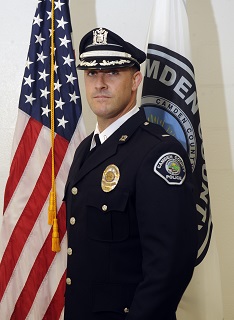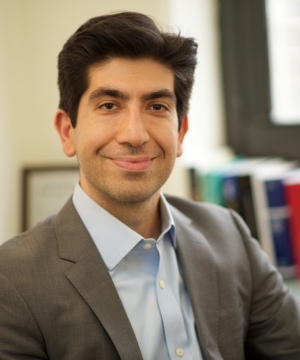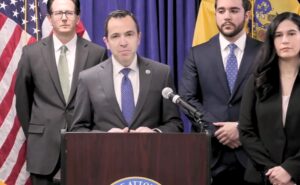Written with an emphasis on the sanctity of life, the new policy was endorsed by the NJ ACLU and the NYU Law School Policing Project as well as the department FOP Lodge.
By Matt Skoufalos | August 22, 2019
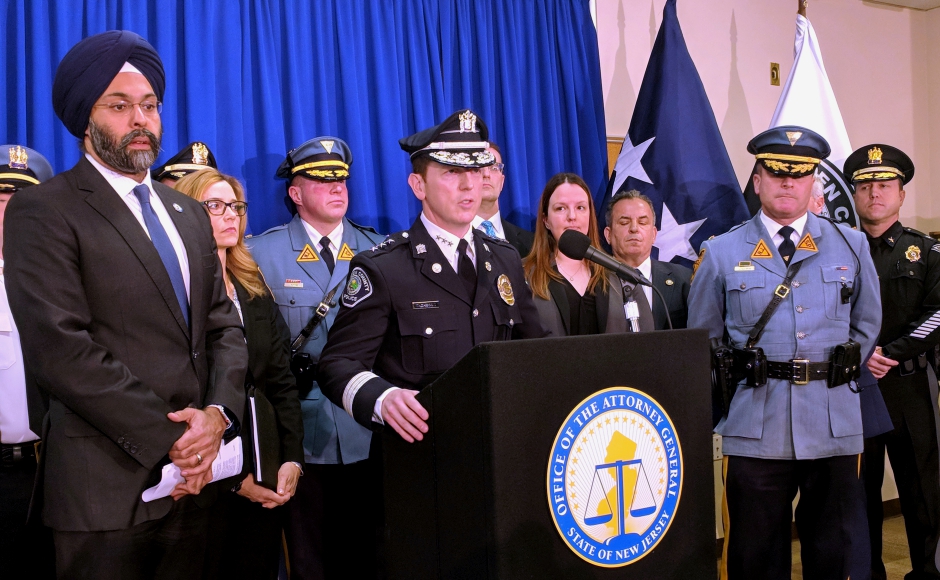
Flanked by the NJ Attorney General Gurbir Grewal (left) Camden County Police Chief J. Scott Thomson speaks at the Operation Stone Wall press conference. Credit: Matt Skoufalos.
In an effort to raise the bar for best practices in community policing, improve officer safety, and prioritize the sanctity of civilian life, the Camden County Police Department (CCPD) has revised its use-of-force guidelines along a new standard that experts say could provide the blueprint for a national model.
The document was drafted with input from outgoing CCPD Chief Scott Thomson, the department’s rank-and-file collective bargaining unit (Fraternal Order of Police Lodge 218), the New York University School of Law Policing Project, and the New Jersey chapter of the American Civil Liberties Union (ACLU).
Its central focus is to provide specific guidance in the use of force by police in myriad situations, establish a review process for every case, and define consequences within the department for those who violate the standard.
At the top of the guidelines are six core principles from which the department derives its direction on such matters:
- Officers may use force only to accomplish specific law enforcement objectives.
- Whenever feasible, officers should attempt to de-escalate confrontations with the goal of resolving encounters without force. Officers may only use force that is objectively reasonable, necessary, and as a last resort.
- Officers must use only the amount of force that is proportionate to the circumstances.
- Deadly force is only authorized as a last resort and only in strict accordance with this directive.
- Officers must promptly provide or request medical aid.
- Employees have a duty to stop and report uses of force that violate any applicable law and/or this directive.
Camden County Police Lt. Kevin Lutz, who oversees the Camden County Police Academy and departmental training, said the new protocols are the culmination of years of work to develop layers of accountability within the agency.
Furthermore, Lutz believes that they will redefine policing in the city by placing a premium on the sanctity of life, by limiting the use of force to a proportionate method of last resort, and by establishing consequences for officers who violate the policies.
“We hold our officers to standards higher than Graham v. Connor,” Lutz said, citing a landmark Supreme Court decision that established a reasonableness standard for the legal use of force on a suspect.
“We’re going to do that through training, culture, and the formalization of policy that’s going to articulate that,” he said.
The baseline of that understanding is the Integrating Communications, Assessments, and Tactics (ICAT) use-of-force training guidelines from the Police Executive Research Forum, of which Thomson is a member.
ICAT training forms the basis of other specialized de-escalation training Camden County police have undergone in dealing with people exhibiting erratic behavior, including those impaired by behavioral health issues.
‘The crux of that training is dealing with people in crisis, with a focus on de-escalation,” Lutz said. “It’s a training that brought together many different topics taught in silos.
“An incident that may have been handled as a crime in progress years ago, our officers are looking at that as a health emergency, and using time as a tactic in doing so,” he said.
Lutz said the new use-of-force policy “very clearly paints a picture of what [standard] we’re going to hold our officers to.
“It’s not about eliminating use of force, it’s about applying an appropriate level of force when necessary, evaluating situations on an ongoing basis, and letting [officers] live by that guardian culture that we aspire to utilize on a daily basis,” he said.
Since the introduction of de-escalation tactics into CCPD culture, Lutz said excessive force complaints have fallen from 64 alleged incidents in 2014 to one such incident this year. He believes a lot of that drop-off can be engineered by better education at the officer training stage, but noted that the new rules have provisions for holding accountable officers who violate the standard.
Under the policy, every use-of-force incident will be evaluated by the watch commander as it happens, Lutz said, adding that “minor training issues” can sometimes be addressed within 24 hours of an incident.
“Culture isn’t established overnight,” Lutz said. “It starts with the selection of the right people in an organization. Then it’s up to the training personnel to reinforce those policies, procedures, actions, on an ongoing basis. We look to recognize de-escalation efforts, life-saving efforts, so we’re reinforcing that life-saving behavior.”
Moreover, he said the new policies have also contributed to new lows in crime reported in the city.
“The success we’ve had in recent years as far as reductions in crime is a direct reflection of the very difficult job our officers are doing on a daily basis,” Lutz said.
Farhang Heydari, Executive Director of the NYU School of Law Policing Project, said the work done by the Camden County Police Department is “at the cutting edge of use-of-force policies” for being “one of the clearest, most specific, and most just use-of-force policies out there.”
“On the substance of what it actually requires, this policy is strong and clear about requiring de-escalation and minimization of force,” Heydari said.
“It’s also clear on the language that officers intervene and report illegal uses of force by other officers, as opposed to the general guidance you see in most policies.”
Heydari said the policy also wins points for being written in language that is “clear and accessible to the public,” and doesn’t rely on police jargon or legalese.
Finally, he also praised its vetting process as an inclusive one that involved feedback from academic researchers and people in the business of law enforcement.
“That’s not something that happens anywhere else,” he said.
“We work with a lot of departments around the country and review a lot of use-of-force policies,” Heydari said. “We shared these with national experts, and the consensus opinion is that this is at the cutting edge of use-of-force policies.”
No policy provides airtight guarantees against abuses of power by those in positions of authority, but Heydari said that the best guidance documents reflect efforts to improve public and officer safety by establishing benchmarks for accountability.
“My takeaway from this is that you have a department that’s trying to be at the cutting edge of minimizing use of force while still keeping people and officers safe,” he said.
“It’s not possible to say that a use of force policy is going to ensure every situation comes out perfect, but this policy shows that the highest levels of the department really care,” Heydari said. “They’re trying to be a leader on this issue.”
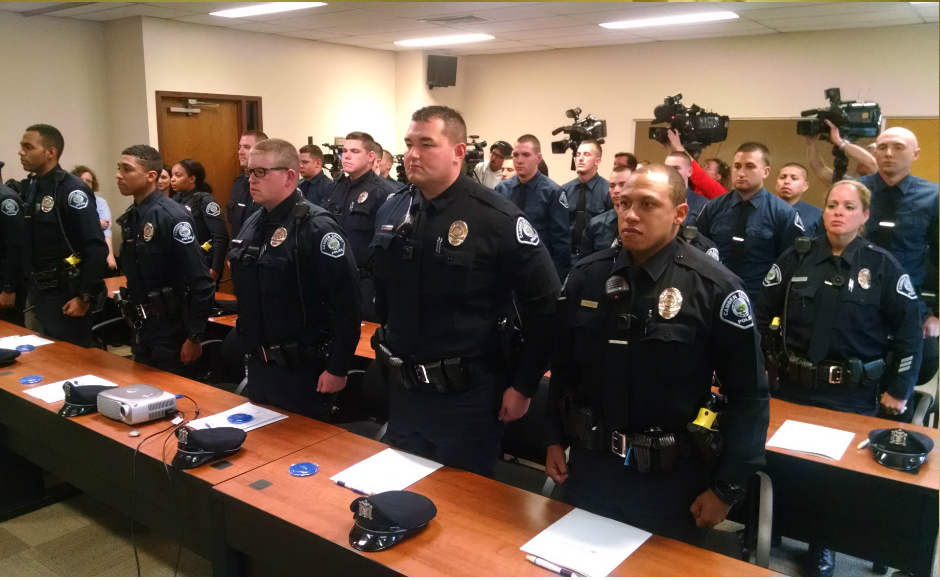
Camden County Police received special education in helping people with autism. Credit: Matt Skoufalos.
That leadership is vital especially since any data collected on excessive force is self-reported by members of the public.
Relying on anecdotal evidence creates an inexact process, which makes it hard to tell if even the best-intended policies are producing the desired results.
“The sad thing is, as a country, we don’t have good use of force data over a period of years,” Heydari said.
“We don’t really even have comprehensive data on what’s happening today.
“What we do know is there are a lot of officer-involved fatalities,” he said. “There are lots of reasons for that: some is poor training, some is the officers involved. It does go to the heart of why policies are important, and why clear policies are particularly important.
“There’s 18,000 police departments and maybe 10,000 solutions to every problem,” Heydari said. “Camden and Chief Thomson have a great reputation in policing circles. My hope is that people will take a look at this policy and see if it works for them.”
Alexander Shalom, Senior Supervising Attorney for ACLU New Jersey, praised the county police department for drafting use-of-force guidelines that seek to raise the bar for the preservation of civilian dignity and the sanctity of life.
“It’s a policy that recognizes that the U.S. Constitution sets this very low floor for police use of force,” Shalom said.
“That doesn’t mean that a good department shouldn’t strive to do much better than that. That’s what a good policy does.
“It also recognizes that there will be times where police officers will use too much force, and it sets up a protocol for investigating the use of too much force,” he said.
Shalom also said he believes the stakeholder-focused approach to drafting the new use-of-force guidelines “could easily serve as a national model” for other departments, regardless of the topic, “because the accessibility transcends the topic.
“Whatever policy police departments develop, they should strive to be accessible to the community and solicit input from all sorts of stakeholders,” he said.
“This is going to build legitimacy from the police department within the community without putting police safety or community safety in jeopardy.”
NJ Pen is free thanks to regular, small contributions. Please support our work.
| Subscription Options |



